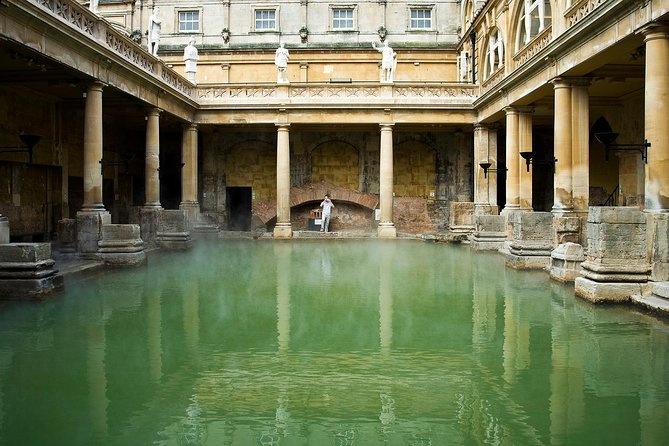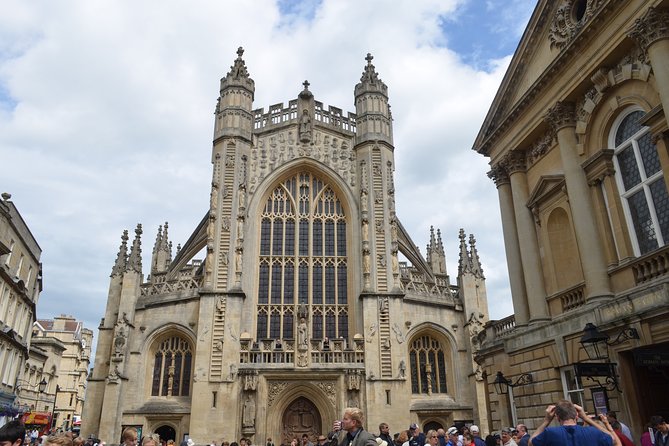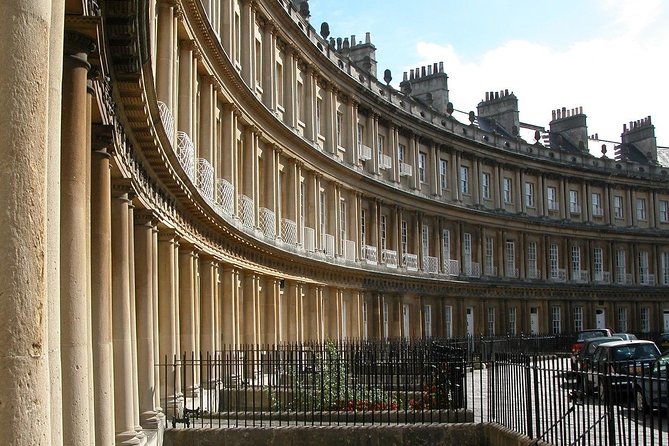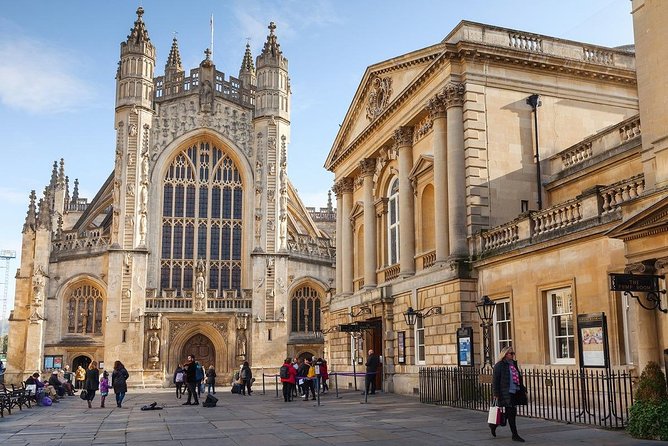The Roman Baths in Bath, England, offer visitors a captivating journey back in time. Explore the remarkably well-preserved remains of the ancient bath complex, including the iconic Great Bath, fed by natural hot springs believed to have curative powers. As you wander the site, you’ll also uncover Bath’s rich architectural legacy, from the striking Georgian townhouses to the grand Neoclassical Pump Rooms. This walking tour provides a comprehensive understanding of the city’s development through the ages, leaving you eager to discover more about Bath’s remarkable history.
Key Points

- The Roman Baths complex in Bath, with its famous Great Bath fed by natural hot springs, is a well-preserved testament to ancient Roman spa town Aquae Sulis.
- A walking tour of Bath highlights the city’s rich architectural legacy, from the striking Georgian townhouses of The Circus to the grand Neoclassical Pump Rooms.
- The tour provides insights into the social and religious significance of the Roman Baths in Roman Britain and the prosperous Georgian period in Bath’s history.
- Key landmarks along the tour include the imposing Bath Abbey, the stunning Royal Crescent, and the picturesque Pulteney Bridge with its shops and restaurants.
- The tour is suitable for families, with accessibility features and a maximum of 15 travelers for a personalized experience, though it requires a moderate level of physical fitness.
Bath’s Ancient Roman History
Bath’s ancient Roman history dates back to the 1st century AD, when the city was founded as a spa town known as Aquae Sulis.
The Romans built the famous Roman Baths complex, featuring the well-preserved Great Bath, which was the centerpiece of the town and drew visitors from across the Roman empire to bathe in the town’s natural hot springs.
The baths were fed by three natural hot springs, which the Romans believed had curative powers.
The remains of the ancient baths, as well as many other Roman artifacts, are now on display, allowing visitors to step back in time and experience the grandeur of ancient Roman Bath.
If you're enjoying exploring Bath on foot, you'll love these other walking tours we recommend
Exploring the Roman Baths

Visitors to the Roman Baths can explore the remarkably well-preserved remains of this ancient complex, which was the centerpiece of the Roman town of Aquae Sulis.
The highlight is the Great Bath, a grand rectangular pool fed by the site’s natural hot springs.
Visitors can also see the changing rooms, where Romans prepared for bathing rituals, and admire the intricate architectural details and antiquities on display.
The tour provides insight into the social and religious significance of the baths in Roman Britain.
With knowledgeable guides to bring the site’s history to life, visitors gain a deeper understanding of Bath’s rich Roman heritage and the role these baths played in the daily lives of the town’s ancient inhabitants.
Architectural Highlights of Bath

Beyond the Roman Baths, Bath showcases an array of architectural gems that capture the city’s rich historical legacy. From the imposing grandeur of Bath Abbey to the elegant symmetry of the Royal Crescent, the city’s buildings reflect both its Roman and Georgian eras.
Notable highlights include:
- The Circus – A striking circular arrangement of Georgian townhouses that exemplify the city’s 18th-century neoclassical style.
- The Pump Rooms – A stunning Neoclassical building that houses the natural hot springs and was a popular social gathering spot during Bath’s Georgian heyday.
- The Pulteney Bridge – A picturesque stone bridge spanning the River Avon, adorned with charming shops and restaurants.
- The Guildhall – A grand 18th-century structure housing Bath’s civic administration and serving as a hub for community events.
Learning About Georgian Architecture

Georgian architecture embodied a refined, symmetrical aesthetic that dominated much of Bath’s cityscape during the 18th century. Characterized by elegant stone facades, grand proportions, and precise geometrical layouts, the Georgian style left an indelible mark on the city’s built environment.
Notable examples of Georgian architecture in Bath include the iconic Royal Crescent and the Bath Assembly Rooms. As the table below illustrates, these landmarks showcase the hallmarks of the Georgian style:
| Feature | Description |
|---|---|
| Façade | Elegant stone construction, symmetrical design |
| Windows | Large, evenly spaced sash windows |
| Roofline | Flat or gently sloping roofs, decorative chimneys |
| Layout | Formal, ordered arrangement of buildings |
This architectural legacy continues to captivate visitors, offering a glimpse into Bath’s prosperous Georgian heyday.
Landmarks Along the Walking Tour

The walking tour showcases Bath’s renowned landmarks, including the imposing Bath Abbey, whose soaring Gothic architecture dominates the city center.
Admire the stately Royal Crescent, a stunning example of Georgian architecture with its sweeping curve of 30 terraced houses.
Marvel at the intricate carvings and columns of the Circus, a circular Georgian townhouse development.
Explore the Pump Rooms, a grand 18th-century building that once housed the social hub of Bath’s high society.
Discover the Pulteney Bridge, a picturesque Georgian bridge lined with shops and restaurants.
These landmarks provide a captivating glimpse into Bath’s rich history and architectural heritage.
Want to dig deeper into Bath? We've also reviewed these city tours
Meeting and Ending the Tour

The tour begins at Bath Abbey, a towering Gothic structure that serves as the meeting point, and concludes back at the same location.
Participants will gather outside the abbey before setting off on a journey through Bath’s rich history.
Along the way, the guide will point out key landmarks like the Royal Crescent, Circus, and Pump Rooms.
At the end of the tour, visitors can choose to explore the Roman Baths on their own, taking in the stunning Great Bath and antiquities at their own pace.
With convenient public transportation nearby and accessibility features, this walking tour offers an immersive experience for all visitors to Bath.
Additional Tour Information

Confirmation is provided upon booking for this walking tour, ensuring participants have all the necessary details. Children must be accompanied by an adult, and the tour is wheelchair accessible with nearby public transportation options. Infant seats are available as well, making it a suitable choice for families.
Moderate physical fitness is required, as the tour involves a fair amount of walking through the historic city. The group size is limited to a maximum of 15 travelers to provide a more personalized experience. Importantly, this tour is non-refundable, and no changes are allowed once booked. However, in the event of weather-related cancellations or lack of minimum travelers, guests will be offered the option of a different tour date or a full refund.
Some additional key details about this tour:
- Gratuities aren’t included in the tour price.
- Bath entrance fee is optional and can be purchased separately.
- The tour departs either in the morning or afternoon.
- A professional guide leads the walking tour.
Booking and Cancellation Policies

Flexibility in booking and cancellation is limited for this walking tour, as it is non-refundable and does not allow changes once reserved. However, in the event of tour cancellations due to weather or insufficient participants, guests receive the option to reschedule or obtain a full refund.
| Booking Policies | Cancellation Policies |
|---|---|
| Non-refundable | Different date or full refund offered |
| No changes allowed | Tour cancelled due to weather or minimum travelers |
| Confirmation upon booking | – |
| Children must be accompanied | – |
| Max 15 travelers | – |
Frequently Asked Questions
Is Photography Allowed Inside the Roman Baths?
Photography is allowed inside the Roman Baths, but visitors are asked to refrain from using flash. Capturing the remarkable architecture and historic artifacts is permitted, providing an opportunity to document one’s visit to this UNESCO-listed site.
Can I Bring My Own Food and Drinks on the Tour?
Guests are generally not allowed to bring their own food and drinks on the walking tour. The tour focuses on exploring the sights and learning about the history, and participants are expected to follow the guidelines set by the tour operator.
Are There Any Discounts Available for Seniors or Students?
Many tour operators offer discounted rates for seniors and students. However, the availability and details of any discounts for this specific tour are not provided in the information given. It’s best to check with the tour provider directly.
Is the Tour Available in Languages Other Than English?
The tour is offered in multiple languages, including English. Guests should inquire about language options when booking to ensure the tour is available in their preferred language. Translations may incur an additional fee.
Can I Extend the Duration of the Tour if I Wish to Explore Further?
Guests can request to extend the duration of the tour if they wish to explore the city further. However, this may incur an additional fee and require coordination with the tour operator.
Recap
The Roman Baths and Bath city walking tour offers a captivating journey through the city’s rich history.
Visitors can explore the well-preserved ancient baths, admire stunning Georgian architecture, and gain a comprehensive understanding of Bath’s development.
The tour provides an immersive experience, showcasing the city’s architectural legacy and the enduring legacy of its Roman past.
More Walking Tours in Bath
More Tours in Bath
More Tour Reviews in Bath
- Bath: Virtual Reality Spa and Meditation Journey
- Bath: Guided Tour of Iconic Bridgerton Filming Locations
- Bath: Christmas Market and City Highlights Walking Tour
- Bath: Vineyard Tour, Wine Tasting, and Music Pairing
- Bath: Guided Walking Tour with Beer Tastings
- Bath: Bespoke Jane Austen-inspired Guided Tours
Not for you? Here's more things to do in Bath we have recnetly reviewed
- Bath: City Walking Tour & Exploration Game
- Hop on with Jane Austen in Bath : Bus and walking tour
- Stonehenge & More: Secret England Tour for 2-8 guests
- Photo Tours in Bath: Walking tour with local expert guide
- From Bath: Salisbury and the Jurassic Coast Small Group Tour
- London: Warwick Castle and Blenheim Palace
- City of Bath: British Wine and Cheese Tasting Experience
- Cotswolds: Hidden, Dark Age England Tour for 2-8 Travellers
- Explore Bath in Spanish: With Olga, local guide
- Bath: Guided Relaxation and Sound Bath
- Bath: Best of Bath Walking Tour Ltd, Georgian Tour.
- Bath: Make and Bake a Cream Tea Experience
